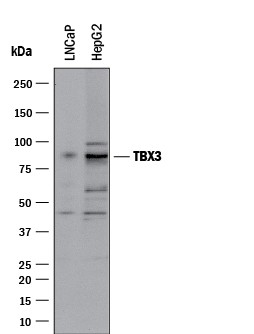Human TBX3 Antibody Summary
Ser321-Thr483
Accession # O15119
Applications
Please Note: Optimal dilutions should be determined by each laboratory for each application. General Protocols are available in the Technical Information section on our website.
Scientific Data
 View Larger
View Larger
Detection of Human TBX3 by Western Blot. Western blot shows lysates of HeLa human cervical epithelial carcinoma cell line and Daudi human Burkitt's lymphoma cell line. PVDF membrane was probed with 1 µg/mL of Goat Anti-Human TBX3 Antigen Affinity-purified Polyclonal Antibody (Catalog # AF4509) followed by HRP-conjugated Anti-Goat IgG Secondary Antibody (HAF109). A specific band was detected for TBX3 at approximately 80 kDa (as indicated). This experiment was conducted under reducing conditions and using Immunoblot Buffer Group 3.
 View Larger
View Larger
Detection of Human TBX3 by Western Blot. Western blot shows lysates of LNCaP human prostate cancer cell line and HepG2 human hepatocellular carcinoma cell line. PVDF membrane was probed with 2 µg/mL of Goat Anti-Human TBX3 Antigen Affinity-purified Polyclonal Antibody (Catalog # AF4509) followed by HRP-conjugated Anti-Goat IgG Secondary Antibody (HAF017). A specific band was detected for TBX3 at approximately 80 kDa (as indicated). This experiment was conducted under reducing conditions and using Western Blot Buffer Group 1.
 View Larger
View Larger
TBX3 in LNCaP Human Cell Line. TBX3 was detected in immersion fixed LNCaP human prostate cancer cell line using Goat Anti-Human TBX3 Antigen Affinity-purified Polyclonal Antibody (Catalog # AF4509) at 5 µg/mL for 3 hours at room temperature. Cells were stained using the NorthernLights™ 557-conjugated Anti-Goat IgG Secondary Antibody (red; NL001) and counterstained with DAPI (blue). Specific staining was localized to nuclei. View our protocol for Fluorescent ICC Staining of Cells on Coverslips.
Reconstitution Calculator
Preparation and Storage
- 12 months from date of receipt, -20 to -70 °C as supplied.
- 1 month, 2 to 8 °C under sterile conditions after reconstitution.
- 6 months, -20 to -70 °C under sterile conditions after reconstitution.
Background: TBX3
TBX3 belongs to the T-box family of transcription factors, which are involved in regulation of developmental processes. TBX3 acts as a transcriptional repressor regulating anterior/posterior axis of the forelimb. Mutations in TBX3 are associated with ulnar-mammary syndrome, affecting limb, apocrine gland, tooth, hair, and genital development. TBX3 has 3 splice isoforms.
Product Datasheets
Citation for Human TBX3 Antibody
R&D Systems personnel manually curate a database that contains references using R&D Systems products. The data collected includes not only links to publications in PubMed, but also provides information about sample types, species, and experimental conditions.
1 Citation: Showing 1 - 1
-
scRNA-sequencing reveals new enteric nervous system roles for GDNF, NRTN, and TBX3
Authors: CM Wright, S Schneider, KM Smith-Edwa, F Mafra, AJL Leembrugge, MV Gonzalez, DR Kothakapa, JB Anderson, BA Maguire, T Gao, TA Missall, MJ Howard, JC Bornstein, BM Davis, RO Heuckeroth
Cellular and Molecular Gastroenterology and Hepatology, 2021-01-11;0(0):.
Species: Human
Sample Types: Whole Tissue
Applications: IHC
FAQs
No product specific FAQs exist for this product, however you may
View all Antibody FAQsReviews for Human TBX3 Antibody
There are currently no reviews for this product. Be the first to review Human TBX3 Antibody and earn rewards!
Have you used Human TBX3 Antibody?
Submit a review and receive an Amazon gift card.
$25/€18/£15/$25CAN/¥75 Yuan/¥2500 Yen for a review with an image
$10/€7/£6/$10 CAD/¥70 Yuan/¥1110 Yen for a review without an image

